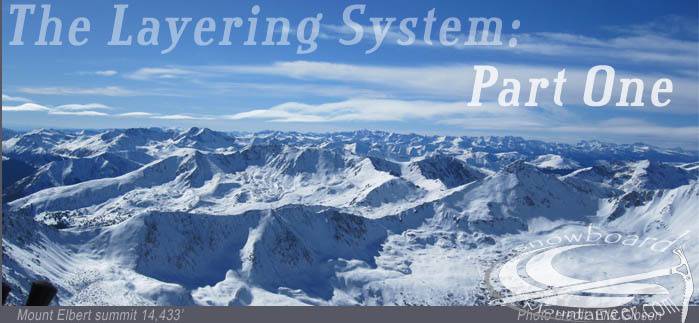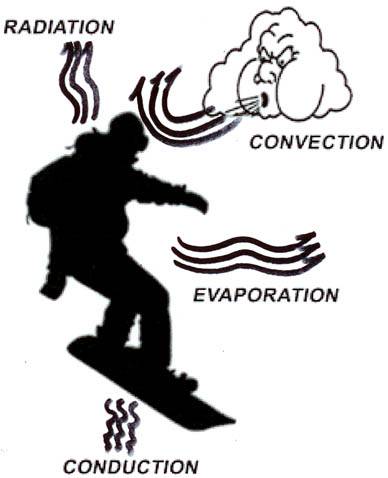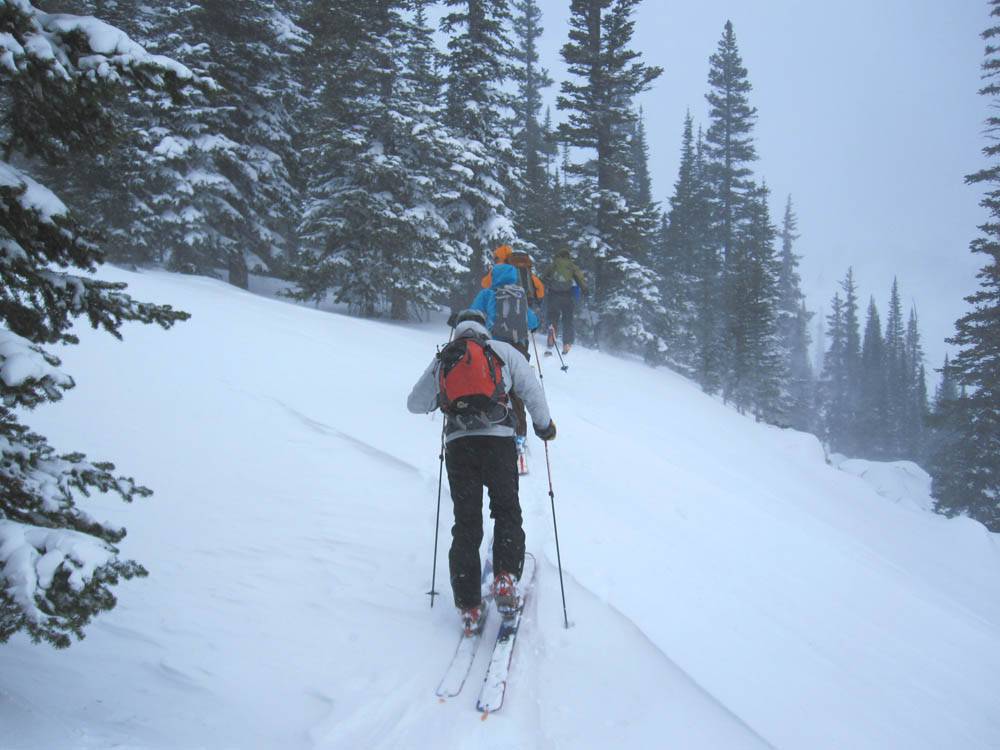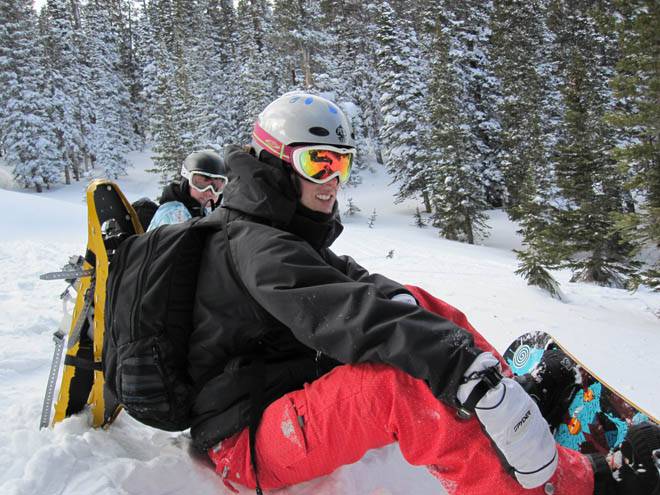The Layering System - Part One

The Layering System
By Shaun Nauman
In order to understand the layering system, we must first understand the reason behind it. I am only going to cover the very basics as it applies to snowboard mountaineering. If you would like further and more in depth reading I have cited all sources and have foot notes for further references.
PART ONE – Hypothermia and heat loss at a glance
The human body has to stay within a few degrees of 98.6 °F to function properly. A core temp below 35.0 °C (95.0 °F)[1] and the body enters Stage One (mild) Hypothermia; Stage Two (moderate) below 32°C (90 °F); Stage Three (severe) below 28 °C (82°F); and Stage Four (profound) below 20 °C (68 °F)[2] . “Paradoxical undressing” usually occurs at stage two and accounts for nearly 50 percent of hypothermia deaths. As the person becomes disoriented, confused, and combative; they may begin discarding their clothing, which, in turn, increases the rate of heat loss.[3][4] Rescuers who are trained in mountain survival techniques are taught to expect this; however, some may assume incorrectly that urban victims of hypothermia have been subjected to a sexual assault.[5]
Further reading on hypothermia: Princeton University has a great publication with more in-depth reading on hypothermia here.. Another excellent article about the onset of hypothermia through the phenomenon of letting go, written in second person narrative here..

It is also key to point out that hypothermia does not only occur in freezing temps. Documented cases of stage one have happen in a house with a thermostat set to 60 °F. Marathon runners have died of hypothermia when the temperature never dropped below 45 °F[6]. To understand why this happens, we will take a brief look at the four main mechanisms of how our bodies lose heat. The layering system will make complete sense once this simple concept of thermodynamics is understood. It’s actually pretty simple, the body attempts to keep a core temperature (Homeostasis) through a balance of heat loss and heat gain.
There are four major mechanisms at work with heat loss;
- Radiation
- Evaporation
- Convection
- Conduction
Let’s take a brief look at each one.
 Russel Hunter, Caleb, Jeff pictured. Colorado Mountain School, Rocky Mountain National Park" width="216" height="162" srcset="http://snowboardmountaineer.com/wp-content/uploads/2013/02/IMG_5984-400x300.jpg 400w, http://snowboardmountaineer.com/wp-content/uploads/2013/02/IMG_5984-700x525.jpg 700w, ../wp-content/uploads/2013/02/IMG_5984.jpg 1000w" sizes="(max-width: 216px) 100vw, 216px"/>
Russel Hunter, Caleb, Jeff pictured. Colorado Mountain School, Rocky Mountain National Park" width="216" height="162" srcset="http://snowboardmountaineer.com/wp-content/uploads/2013/02/IMG_5984-400x300.jpg 400w, http://snowboardmountaineer.com/wp-content/uploads/2013/02/IMG_5984-700x525.jpg 700w, ../wp-content/uploads/2013/02/IMG_5984.jpg 1000w" sizes="(max-width: 216px) 100vw, 216px"/>Russel Hunter, Caleb, Jeff pictured. Colorado Mountain School, Rocky Mountain National Park
RADIATION
Heat generated from within the body is given-off to the surrounding atmosphere, most of which is lost from your head. Heat is primarily generated in muscle tissue, including the heart, and in the liver, while it is lost through the skin (90%) and lungs (10%).[7]
Radiation as it applies: Wear a hat, cautious of exposed skin. If you are trying to cool your core temperature down to keep from sweating, removing your hat is a fast way to regulate your temperature. Just be vigilant not to allow your temp to cool too fast.
 Matt Rix, James Peak Wilderness" width="216" height="288" srcset="http://snowboardmountaineer.com/wp-content/uploads/2013/02/IMG_7069-225x300.jpg 225w, ../wp-content/uploads/2013/02/IMG_7069.jpg 600w" sizes="(max-width: 216px) 100vw, 216px"/>
Matt Rix, James Peak Wilderness" width="216" height="288" srcset="http://snowboardmountaineer.com/wp-content/uploads/2013/02/IMG_7069-225x300.jpg 225w, ../wp-content/uploads/2013/02/IMG_7069.jpg 600w" sizes="(max-width: 216px) 100vw, 216px"/>Matt Rix, James Peak Wilderness
EVAPORATION
When you sweat or when your skin or clothing gets wet, the evaporation of that liquid (i.e., the change from liquid to vapor form) promotes heat loss, and the natural result is a cooling effect. Evaporation is the primary cooling function of your body, but in the alpine environment it can be deadly because you can cool too fast. The body can only re-warm itself at a rate of 3.6 degrees per hour[8].
Evaporation as it applies: reduce sweat by wearing wicking fabrics. Never wear cotton in the backcountry, even in the summer. Sweating can also be controlled by shedding your mid layer, and adjusting ventilation such as pit zips and leg zips. You want to be constantly vigilant of your body temperature and keep moisture to an absolute minimum by adjusting layers BEFORE you begin to sweat.

CONVECTION
Convection is the process of air or water flowing by the skin and carrying away body heat. This where the principle of “wind-chill” comes in to play, wind-chill is dangerous because it can combine evaporation with convection heat loss cooling you at double the rate. Between the two, you can enter stage one hypothermia in less than a minute.
Convection as it applies: Windstopper® GORE-TEX® or GORE fabrics rated at a high thread count will minimize or stop wind and convection heat loss. It is important to first mitigate evaporation (sweat). Be vigilant of an approach to a ridge line or summit prior to getting there and adjusting ventilation.

Lacee Gordon, Evan Plaice – James Peak Wilderness
CONDUCTION
The body conducts heat to whatever the skin is in direct contact with. Conductive heat loss occurs when the skin is subjected to either cold air or water, but it is especially critical in water, as your body loses heat about 32 times faster[9] in water than in air of the same temperature. Conduction also occurs when in contact with the ground, this is the main reason behind sleeping pads, because they don’t allow conduction of your body heat in to the ground. I was introduced to a substance known as aerogel[10] from Laurie Leveton, and after some research on the conductive properties (hint: none), I would not be surprised to see this substance used [more] in the outdoor industry in the near future.
Conduction as it applies: Again minimize evaporation (sweat). Be cautious of what you come in contact with. Taking a break on a rock, or adjusting a binding while sitting in the snow are factors of conduction. Placing an item such as a pack between you and a colder object can minimize conduction.
So now that we briefly understand the four mechanisms behind heat loss, the layering system is about to make more sense. In Part Two we will put this together and cover the Layering System.
